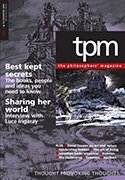Giorgio Baruchello tries to distinguish between thaw and meltdown
 If men were capable of reproducing without the aid of women, then the Irish could claim that Iceland was colonised by them – around the 8th century – and not by the Vikings. Unfortunately, the Irish monks that had chosen such a vast, cold island in the north Atlantic as their hermitage were never able to sustain an actual population. Moreover, in the 9th century, when they saw the sails of well-known and much-feared Norse longboats approaching Iceland’s shores, they decided that it was time to choose another location. Nevertheless, Celtic blood has been running in the veins of Icelanders since the time of settlement, which official historiography dates as starting in 874 AD. To be precise, on their way to Iceland, the Vikings seized women – and other slave labour – in Celtic Ireland and northern Scotland. Evidently, they were roughly aware of how human beings should reproduce.
If men were capable of reproducing without the aid of women, then the Irish could claim that Iceland was colonised by them – around the 8th century – and not by the Vikings. Unfortunately, the Irish monks that had chosen such a vast, cold island in the north Atlantic as their hermitage were never able to sustain an actual population. Moreover, in the 9th century, when they saw the sails of well-known and much-feared Norse longboats approaching Iceland’s shores, they decided that it was time to choose another location. Nevertheless, Celtic blood has been running in the veins of Icelanders since the time of settlement, which official historiography dates as starting in 874 AD. To be precise, on their way to Iceland, the Vikings seized women – and other slave labour – in Celtic Ireland and northern Scotland. Evidently, they were roughly aware of how human beings should reproduce.
Contrary to certain pseudo-scientific myths, which led Nazi experts to regard the Icelanders as a pure Aryan breed, Iceland has been a less isolated country, and Icelanders a less in-bred community, than many have thought—including a good number of Icelanders. Iceland was never a major hub of European trade, nor was the Icelandic nation a major player in European affairs. Still, its inhabitants travelled far and often, at least until the late Middle Ages. They brought home goods, ideas, and sometimes genes from as distant lands as Russia and the Byzantine Empire. Meanwhile, they settled in Greenland and, for a short period of time, in Newfoundland. Analogous exchanges took place with German, English and Dutch merchants, who visited the Icelandic ports and people fairly regularly until 1602.
In that fateful year, the Danish crown introduced a mercantilist trade monopoly that brought travelling and trading internationally to a halt. This economic policy had disastrous consequences for the near totality of the inhabitants of the country. As masterfully evoked in Nobel-laureate Halldor Laxness’ novel Iceland’s Bell (1943), havoc, misery and destitution burdened the nation – with the notable exception of the conservative elite comprising rich farmers and merchants with strong Danish connections. Whereas Holland, Spain and the Genoese were enjoying their “golden century” and England its Renaissance, Iceland was beginning its true Dark Ages. Moreover, in the 18th century, volcanic eruptions, failing crops and recurrent famines prevented any recovery from taking place, even though the trade monopoly was lifted eventually. It is only in the 19th century that the benefits of free trade in fish and stockfish were felt by the population at large; it was then that they started to think seriously about independence.
For a renewed or even a first golden age, Iceland had to wait until the late 20th century, when its substantial adoption of the Scandinavian development model allowed it to become one of the wealthiest (per capita) and happiest countries on the planet, at least according to all major international reports. This did not last long, though. In 2008, five years after the privatisation of the nation’s largest banks, a massive financial crisis hit Iceland, whose government is currently accepting loans from the IMF and other international creditors in order to avoid sovereign default. Like many other countries on the planet since the early 1990s, Iceland has itself experienced a “meltdown”. Perhaps, as a result of this experience, it will become clear that free trade in capital and currency is not the same thing as free trade in fish and stockfish; or perhaps not.
During Iceland’s history as one of the youngest countries in Europe, literature and religion, rather than philosophy, have played a major role in shaping the national culture. On the one hand, the fundamental sources of national pride and identity have been the medieval Sagas and the Icelandic language, the latter being de-internationalised during the Romantic age as most foreign terms and influences were thoroughly expunged. On the other hand, Christianity first and the Reformation later have provided an immaterial yet solid bridge to Continental Europe and the Nordic countries, which has lasted until the present day.
If we set aside recent attempts by renowned educationalist and moral philosopher Kristján Kristjánsson (b.1959) to extrapolate a quasi-Aristotelian ethics from the Sagas, it is thanks to the latter player – religion – that philosophy was introduced and kept alive in Iceland. The adoption of Christianity, around the year 1000, and the establishment of two bishoprics and several monasteries allowed for intellectual exchanges with chief centres of learning, such as Paris and Rome. Books and clerics would sail over the Atlantic and the North Sea to enrich Iceland’s cultural landscape. The Reformation severed many of these medieval ties, but promoted enough Lutheran theology to prevent philosophical erudition from perishing completely.
As concerns the troubled two centuries that followed the 1500s, Icelanders were generally too worried about survival to have much time for sophisticated intellectual activities. Out of necessity, most inhabitants became Cynics, if lucky enough to be able to satisfy their basic needs. Isolated cases such as Brynjólfur Sveinsson (1605-1675), Páll Björnsson (1621-1706) and Hannes Finsson (1739-1796) show that a modicum of philosophical learning survived amongst the clergy, who could enjoy a slightly more leisurely lifestyle.
In the 19th century the situation improved a little, allowing more Icelanders to have access to literacy and schooling at higher levels. German idealism and, even more, Romantic ideals, swept across the Icelandic intelligentsia, turning Iceland’s cruel mistress – its untamed nature – into another powerful positive symbol of national uniqueness. Poets and the Icelandic language, however, were the main vehicles for this process. Philosophy, despite the efforts by clergymen Hannes Árnason (1812-1879) and Eiríkur Briem (1846-1929), remained marginal.
In this perspective, significant is the fact that the first Icelandic department of philosophical studies was established at the University of Iceland only in 1972, long after the founding of the university itself in Reykjavík in 1911. Some philosophy had been taught there since its inception and, in the 1920s, it became an essential component of philosophicum: a basic curriculum in psychology and philosophy that all students had to take. Psychologist Guðmundur Finnbogason (1873-1944) and educationalist Símon Jóhannes Ágústsson (1904-1976) wrote extensively about philosophical matters, but this was not enough to start an actual programme in philosophy.
New universities were later established in Akureyri (1987), Bifröst (1988) and Reykjavík (1998), which have employed philosophers in various degree programmes, from the social sciences to law. Still, no new department of philosophy has seen the light yet. First of all, there has been no adequate critical mass amongst the student population to justify such a move. Secondly, due to the sheer size of the Icelandic population, philosophers have been “jacks of all trades” capable of contributing to the country’s intellectual life at several different levels, which has included taking part in research and teaching within other disciplinary “pigeonholes”.
As regards the initiators of the one and only department of philosophy in Iceland, they were an interesting and creative blend of diverse philosophical currents, who brought together methodologies and themes originating in Edinburgh, Cambridge, Harvard, Brandeis and Louvain. Of crucial importance with regard to the establishment of the philosophy department were polymath Þorsteinn Gylfason (1942-2005) and the philosopher of culture and later rector of the University of Iceland Páll Skúlason (b.1945). Also, among the founders, was US-born and US-trained Mikael M. Karlsson (b.1943; Michael Marlies before Icelandic naturalisation), who embodies the often underplayed openness of Iceland to foreign “blood” or, as in this case, “brains”. Almost single-handedly, he enabled the creation of a stable and extensive network of academic ties between Iceland and the rest of the world, which is still growing today.
In the 20th century, Iceland has been able to produce, export (many talented Icelandic philosophers have worked abroad) and, occasionally, attract respected members of the international academic community. In addition to the thinkers mentioned above, cultural scholar Sigurður Jóhannesson Nordal (1884-1974), logician Bjarni Jónsson (b.1920), Hume specialist Páll S. Árdal (1924-2003) and bio-ethicist Vilhjálmur Árnason (b.1953) are possibly the best-known names.
Whether Iceland will turn in the 21st century to any of them, or to their colleagues, for new ideas on how to resolve the current economic crisis, thus bringing philosophy centre-stage for the very first time in the nation’s life, history will tell.
Giorgio Baruchello is a professor at the Faculty of Law and Social Sciences at the University of Akureyri in Iceland.
 Email This Post
Email This Post 



a planet with no north pole made of ice sheet is not a healthy dynamic
Per “Whether Iceland will turn in the 21st century …for new ideas on how to resolve the current economic crisis, thus bringing philosophy centre-stage for the very first time in the nation’s life, history will tell”!
Pray, tell us dear professor how the academic discipline of “Philosophy” is going to improve on the ‘old ideas’ of highly trained and skilled economists?
Dear Tim,
Many thanks for your comment.
Please check the contributions on the economic crisis contained in issue 5:1 of Nordicum-Mediterraneum (http://nome.unak.is) for a start.
A more technical made-in-Iceland text on how to improve on failed and failing old ideas is also available online: http://www.thjodmalastofnun.hi.is/WorkingPaper012009c.pdf
Further relevant materials can be retrieved in Canada’s journal Monetary Reform and are discussed regularly by contributors to the New Economics Foundation and GlobalResearch.ca
I hope this helps.
GB